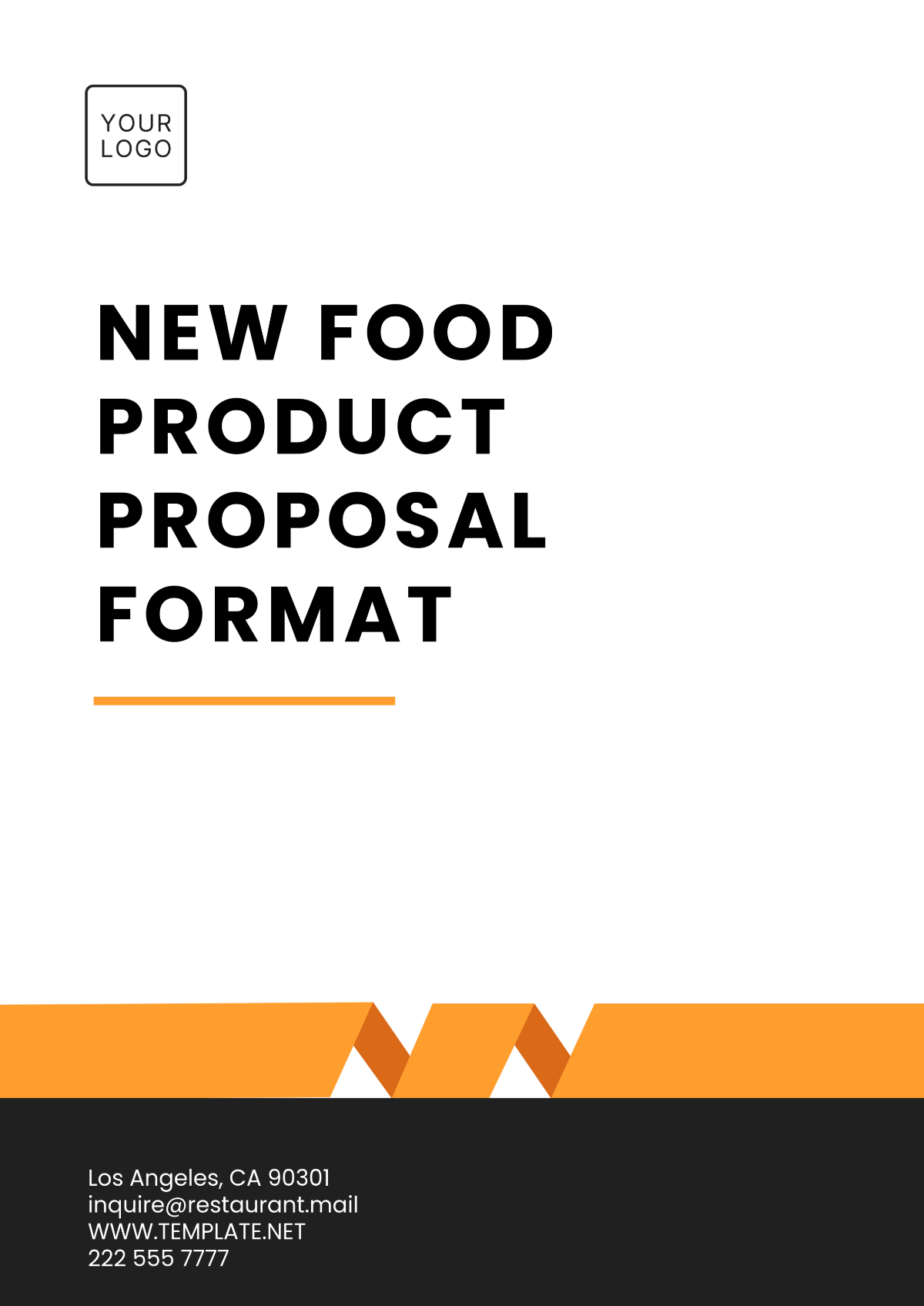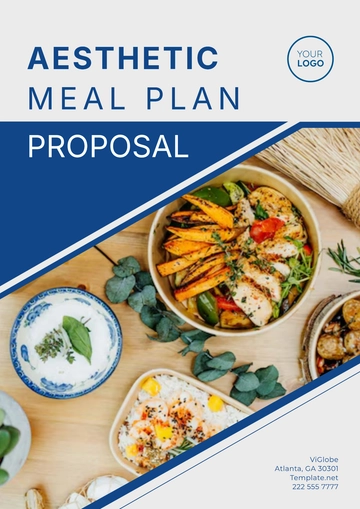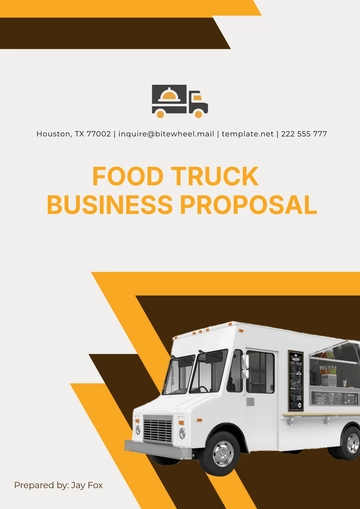Free New Food Product Proposal Format

1. Executive Summary
Product Name: (The name of your food product)
Category: (e.g., snack, beverage, frozen food, etc.)
Target Market: (Who is the product aimed at? E.g., health-conscious consumers, busy professionals, kids, etc.)
Unique Selling Proposition (USP): (What makes your product unique or different from competitors?)
Overview: (Brief summary of the product concept and its potential in the market)
2. Product Concept
Description: (A detailed description of the product, including ingredients, flavors, packaging, etc.)
Formulation: (Provide the recipe, formulation, or detailed breakdown of how the product is made)
Shelf Life: (How long does the product stay fresh? Any preservation methods?)
Nutritional Information: (Include key nutritional details if applicable—calories, fat, sugar, etc.)
Packaging: (Type of packaging, size, design, and sustainability considerations)
Branding/Positioning: (How do you want the product to be perceived by the market?)
3. Market Research
Target Audience: (Who is the product intended for? Include demographics, psychographics, and buying behavior.)
Market Trends: (Discuss current trends in the food industry relevant to your product, e.g., plant-based, organic, gluten-free, etc.)
Competitive Landscape: (Identify key competitors, their products, pricing, strengths, and weaknesses)
Consumer Insights: (Insights from market research or consumer feedback on similar products)
Market Size and Potential: (Provide data on the market opportunity and growth potential for this category)
4. Product Development Plan
Development Timeline: (Timeframe for product development, from concept to launch)
R&D and Testing: (Details about product testing, prototype stages, and feedback collection)
Ingredients and Sourcing: (Where and how will you source ingredients, ensuring quality and consistency?)
Manufacturing Process: (Outline the production process, facilities, or partners involved)
Regulatory Approvals: (Mention any food safety standards or certifications needed, such as FDA approval, organic certification, etc.)
5. Marketing and Sales Strategy
Brand Strategy: (How will you build the brand, including brand voice, positioning, and values?)
Marketing Channels: (Where will the product be marketed? E.g., online, retail, food service, etc.)
Pricing Strategy: (What will be the price point for the product? Is it premium, value, or economy?)
Promotions: (Plans for initial promotions, discounts, launch events, influencer partnerships, etc.)
Distribution Strategy: (Retailers, online marketplaces, foodservice providers, etc.)
Sales Forecast: (Project the sales volume for the first 12 months or more)
6. Financial Plan
Initial Investment: (The amount needed to develop the product, including R&D, manufacturing, marketing, etc.)
Cost of Goods Sold (COGS): (The cost to produce one unit of the product)
Break-even Analysis: (How many units need to be sold to cover the initial investment?)
Revenue Projections: (Expected income from the product over a set period—monthly or annually)
Profit Margins: (Target profit margins per unit and overall)
Funding Requirements: (If seeking investment, how much capital is needed, and how will it be used?)
7. Risk Analysis
Market Risks: (Potential challenges in the market, like consumer behavior changes or competition)
Operational Risks: (Supply chain, production delays, quality control)
Financial Risks: (Uncertainty in sales volume, unforeseen expenses)
Regulatory Risks: (Compliance with food safety regulations, labeling, etc.)
8. Conclusion
Summary: (Recap the key points: why this product is needed, its potential, and why it will succeed)
Call to Action: (What are the next steps? Do you need approval, investment, or a meeting?)
Appendices (if applicable)
Detailed Market Research Data
Product Photos or Mockups
Recipes or Formulation Sheets
Regulatory or Certifications Documents
Financial Worksheets
- 100% Customizable, free editor
- Access 1 Million+ Templates, photo’s & graphics
- Download or share as a template
- Click and replace photos, graphics, text, backgrounds
- Resize, crop, AI write & more
- Access advanced editor
Introduce your innovation with Template.net’s New Food Product Proposal Format Template. Customizable and professional, it’s ideal for showcasing new food products to clients or investors. Editable in our AI Editor Tool, this template ensures clarity and precision. Download this template to craft an impactful proposal.
You may also like
- Business Proposal
- Research Proposal
- Proposal Request
- Project Proposal
- Grant Proposal
- Photography Proposal
- Job Proposal
- Budget Proposal
- Marketing Proposal
- Branding Proposal
- Advertising Proposal
- Sales Proposal
- Startup Proposal
- Event Proposal
- Creative Proposal
- Restaurant Proposal
- Blank Proposal
- One Page Proposal
- Proposal Report
- IT Proposal
- Non Profit Proposal
- Training Proposal
- Construction Proposal
- School Proposal
- Cleaning Proposal
- Contract Proposal
- HR Proposal
- Travel Agency Proposal
- Small Business Proposal
- Investment Proposal
- Bid Proposal
- Retail Business Proposal
- Sponsorship Proposal
- Academic Proposal
- Partnership Proposal
- Work Proposal
- Agency Proposal
- University Proposal
- Accounting Proposal
- Real Estate Proposal
- Hotel Proposal
- Product Proposal
- Advertising Agency Proposal
- Development Proposal
- Loan Proposal
- Website Proposal
- Nursing Home Proposal
- Financial Proposal
- Salon Proposal
- Freelancer Proposal
- Funding Proposal
- Work from Home Proposal
- Company Proposal
- Consulting Proposal
- Educational Proposal
- Construction Bid Proposal
- Interior Design Proposal
- New Product Proposal
- Sports Proposal
- Corporate Proposal
- Food Proposal
- Property Proposal
- Maintenance Proposal
- Purchase Proposal
- Rental Proposal
- Recruitment Proposal
- Social Media Proposal
- Travel Proposal
- Trip Proposal
- Software Proposal
- Conference Proposal
- Graphic Design Proposal
- Law Firm Proposal
- Medical Proposal
- Music Proposal
- Pricing Proposal
- SEO Proposal
- Strategy Proposal
- Technical Proposal
- Coaching Proposal
- Ecommerce Proposal
- Fundraising Proposal
- Landscaping Proposal
- Charity Proposal
- Contractor Proposal
- Exhibition Proposal
- Art Proposal
- Mobile Proposal
- Equipment Proposal
- Student Proposal
- Engineering Proposal
- Business Proposal





























